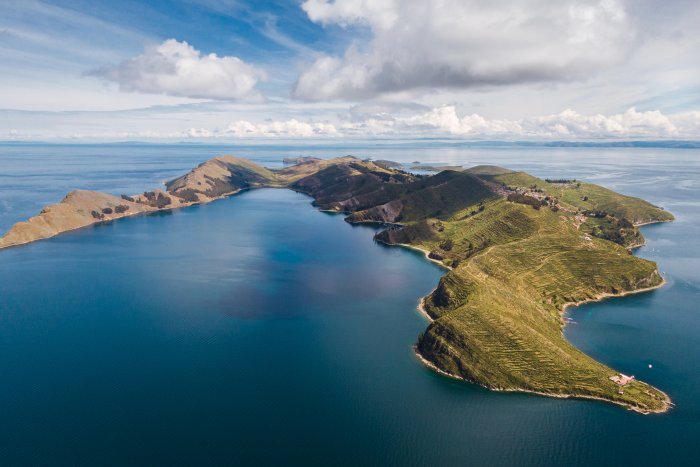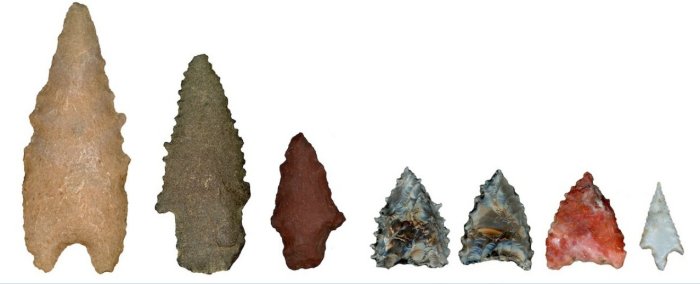Jan Bartek – AncientPages.com – When did archery arise in the Americas? And what were the effects of this technology on society?
These questions have long been debated among anthropologists and archaeologists. But a study led by a University of California, Davis, anthropologist, is shining light on this mystery. The work is published in Quaternary International.

Aerial view of Island of the Sun (Spanish: Isla del Sol ) on Lake тιтicaca. Credit: Adobe Stock – R.M. Nunes
Focusing on the Lake тιтicaca Basin in the Andes mountains, anthropologists found through analysis of 1,179 projectile points that the rise of archery technology dates to around 5,000 years ago. Previous research held that archery in the Andes emerged around 3,000 years ago.
The new research indicates that the adoption of bow-and-arrow technology coincided with both the expansion of exchange networks and the growing tendency for people to reside in villages.
“We think our paper is groundbreaking because it gives us a chance to see how society changed throughout the Andes throughout ancient times by presenting a huge number of artifacts from a vast area of South America,” said Luis Flores-Blanco, an anthropology doctoral student and corresponding author of the paper. “This is among the first instances in which Andean archaeologists have investigated social complexity through the quanтιтative analysis of stone tools.”
Researchers said increasing social complexity in the region is usually investigated through analysis of monumental architecture and ceramics rather than projectile points, which are historically linked to foraging communities.
Pooling from 10,000 years of history
For the study, the team examined more than a thousand projectile points created over 10,000 years. Each projectile point originated in the Lake тιтicaca Basin, specifically the Ilave and Ramis valleys, which are located southwest and northwest of the basin, respectively.
Flores-Blanco said it’s among the highest plateau lands explored and conquered by humans, with Lake тιтicaca sitting at an elevation of 12,500 feet.
“At тιтicaca, Andeans accomplished the remarkable achievement of domesticating plants like the potato, leaving behind a nutritious legacy that is still appreciated today,” he said. “On top of that, the Tiwanaku were one of the major Andean civilizations that built their vast territory here. Even the Inca Empire claimed this territory was their mythical place of origin. Our study digs even deeper and goes to the roots of this Andean civilization.”
In their analysis, Flores-Blanco and his colleagues considered each projectile’s date of origin and then measured its length, width, thickness and weight. They noticed that older projectile points—from the Early Archaic through the Late Archaic—were larger. A significant decrease in size occurred during the Terminal Archaic period, around 5,000 years ago. The team hypothesized that this size shift indicates a change in preference from spear-throwing technology to bow-and-arrow technology, but without abandoning the old technologies.

Focusing on the Lake тιтicaca Basin in the Andes mountains, a team of anthropologists found through analysis of 1,179 projectile points that the rise of archery technology dates to around 5,000 years ago. Credit: Luis Flores-Blanco
In addition, the team compared their projectile data to archaeological data from the region concerning settlement sizes, raw material availability and cranial trauma data. During the Terminal Archaic period, settlement sizes increased but the total number of settlement sites decreased, researchers said. Not only that, but the inhabitants lacked signs of social violence, even though they had access to exotic raw materials.
“Based on our discovery, we can suggest that bow-and-arrow technology could have maintained and ensured adherence to emerging social norms that were crucial, such as those observed in the development of new social insтιтutions, like obsidian exchange hubs or among individuals establishing residence in expanding villages,” Flores-Blanco said.
See also: More Archaeology News
Flores-Blanco co-authored the study with Lucero Cuellar, National University of San Marcos; Mark Aldenderfer, UC Merced; Charles Stanish, University of South Florida; and Randall Haas, University of Wyoming and formerly of UC Davis.
The study was published in the journal Quaternary International
Written by Jan Bartek – AncientPages.com Staff Writer





